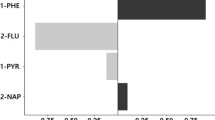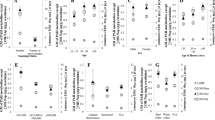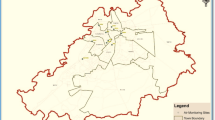Abstract
Linzhou, China has one of the highest rates of esophageal squamous cell carcinoma in the world. Exposure to carcinogenic polycyclic aromatic hydrocarbons (PAHs), such as benzo[a]pyrene (BaP), may have a role in this increased risk. To better understand PAH sources, we measured PAHs in the air and food of 20 non-smokers over multiple days and compared the concentrations with a urinary PAH biomarker, 1-hydroxypyrene glucuronide (1-OHPG). Sampling occurred over 4 consecutive days. Kitchen air samples (days 2–3) and duplicate diet samples (days 1–4) were analyzed for 14 or more unique PAHs, including BaP. Daily urine samples (days 1–3) were analyzed for 1-OHPG. Mixed-effects models were used to evaluate the associations between air or food PAH concentrations and urine 1-OHPG concentrations. The median kitchen air BaP concentration was 10.2 ng/m3 (interquartile range (IQR): 5.1–20.2 ng/m3). The median daily food BaP concentration and intake were 0.08 ng/g (IQR=0.04–0.16 ng/g) and 86 ng/day (IQR=41–142 ng/day), respectively. The median 1-OHPG concentration was 3.36 pmol/ml (IQR=2.09–6.98 pmol/ml). In mixed-effects models, 1-OHPG concentration increased with same-day concentration of food BaP (P=0.07). Although PAH concentrations in air were not associated with 1-OHPG concentrations, the high concentrations of PAHs in both air and food suggest that they are both important routes of exposure to PAHs in this population. Further evaluation of the role of PAH exposure from air and food in the elevated rates of esophageal cancer in this region is warranted.
This is a preview of subscription content, access via your institution
Access options
Subscribe to this journal
Receive 6 print issues and online access
$259.00 per year
only $43.17 per issue
Buy this article
- Purchase on Springer Link
- Instant access to full article PDF
Prices may be subject to local taxes which are calculated during checkout
Similar content being viewed by others
References
Ke L. Mortality and incidence trends from esophagus cancer in selected geographic areas of China circa 1970–90. Int J Cancer 2002: 102: 271–274.
Blot W.J., McLaughlin J.K., and Fraumeni J.F.J. Esophageal Cancer. In: Schottenfeld D., Fraumeni Jr J.F. (Eds.). Int J Cancer Epidemiology and Prevention. Oxford University Press: Oxford, 2006, pp 697–706.
Freedman N.D., Abnet CC., Leitzmann M.F., Mouw T., Subar A.F., Hollenbeck A.R., et al. A prospective study of tobacco, alcohol, and the risk of esophageal and gastric cancer subtypes. Am J Epidemiol 2007: 165: 1424–1433.
Nasrollahzadeh D., Kamangar F., Aghcheli K., Sotoudeh M., Islami F., Abnet C.C., et al. Opium, tobacco, and alcohol use in relation to oesophageal squamous cell carcinoma in a high-risk area of Iran. Br J Cancer 2008: 98: 1857–1863.
Tran G.D., Sun X.D., Abnet C.C., Fan J.H., Dawsey S.M., Dong Z.W., et al. Prospective study of risk factors for esophageal and gastric cancers in the Linxian general population trial cohort in China. Int J Cancer 2005: 20: 113.
IARC (International Agency for Research on Cancer). Monograph on Some Non-Heterocyclic Polycyclic Aromatic Hydrocarbons and Some Related Exposures Vol. 92. IARC Press: Lyon, France, 2010.
Abedi-Ardekani B., Kamangar F., Hewitt S.M., Hainaut P., Sotoudeh M., Abnet C.C., et al. Polycyclic aromatic hydrocarbon exposure in oesophageal tissue and risk of oesophageal squamous cell carcinoma in north-eastern Iran. Gut 2010: 59: 1178–1183.
Fagundes R.B., Abnet C.C., Strickland P.T., Kamangar F., Roth M.J., Taylor P.R., et al. Higher urine 1-hydroxy pyrene glucuronide (1-OHPG) is associated with tobacco smoke exposure and drinking mate in healthy subjects from Rio Grande do Sul, Brazil. BMC Cancer 2006: 6: 139.
Kamangar F., Strickland P.T., Pourshams A., Malekzadeh R., Boffetta P., Roth M.J., et al. High exposure to polycyclic aromatic hydrocarbons may contribute to high risk of esophageal cancer in northeastern Iran. Anticancer Res 2005: 25: 425–428.
Roth M.J., Qiao Y.L., Rothman N., Tangrea J.A., Dawsey S.M., Wang G.Q., et al. High urine 1-hydroxypyrene glucuronide concentrations in Linxian, China, an area of high risk for squamous oesophageal cancer. Biomarkers 2001: 6: 381–386.
Roth M.J., Strickland K.L., Wang G.Q., Rothman N., Greenberg A., and Dawsey S.M. High levels of carcinogenic polycyclic aromatic hydrocarbons present within food from Linxian, China may contribute to that region's high incidence of oesophageal cancer. Eur J Cancer 1998: 34: 757–758.
Wornat M.J., Ledesma E.B., Sandrowitz A.K., Roth M.J., Dawsey S.M., Qiao Y.L., et al. Polycyclic aromatic hydrocarbons identified in soot extracts from domestic coal-burning stoves of Henan Province, China. Environ Sci Technol 2001: 35: 1943–1952.
Hakami R., Mohtadinia J., Etemadi A., Kamangar F., Nemati M., Pourshams A., et al. Dietary intake of benzo(a)pyrene and risk of esophageal cancer in north of Iran. Nutr Cancer 2008: 60: 216–221.
NIOSH (National Institute of Occupational Safety and Health). Polynuclear aromatic hydrocarbons by HPLC. Method 5506. In: NIOSH Manual of Analytical Methods 4th edn. Cincinatti, OH, 1998.
Richter B., Jones B., Ezzell J., and Porter N. Accelerated solvent extraction: a technique for sample preparation. Anal Chem 1996: 68: 1033–1039.
Strickland P.T., Kang D., Bowman E.D., Fitzwilliam A., Downing T.E., Rothman N., et al. Identification of 1-hydroxypyrene glucuronide as a major pyrene metabolite in human urine by synchronous fluorescence spectroscopy and gas chromatography-mass spectrometry. Carcinogenesis 1994: 15: 483–487.
Larsen K. Creatinine assay by a reaction kinetic principle. Clin Chim Acta 1972: 41: 209–217.
U.S. EPA (Environmental Protection Agency). 2011. Exposure factors handbook: 2011 edition. National Center for Environmental Assessment, Washington, DC; EPA/600/R-09/052F. Available from the National Technical Information Service, Springfield, VA, and online at http://www.epa.gov/ncea/efh.
Jiang Y.F., Wang X.T., Wang F., Jia Y., Wu M.H., Sheng G.Y., et al. Levels, composition profiles and sources of polycyclic aromatic hydrocarbons in urban soil of Shanghai, China. Chemosphere 2009: 75: 1112–1118.
Lv J., Xu R., Wu G., Zhang Q., Li Y., Wang P., et al. Indoor and outdoor air pollution of polycyclic aromatic hydrocarbons (PAHs) in Xuanwei and Fuyuan, China. J Environ Monit 2009: 11: 1368–1374.
Yunker M.B., Macdonald R.W., Vingarzan R., Mitchell R.H., Goyette D., and Sylvestre S. PAHs in the Fraser River basin: a critical appraisal of PAH ratios as indicators of PAH source and composition. Organic Geochem 2002: 33: 489–515.
Barr D.B., Wilder L.C., Caudill S.P., Gonzalez A.J., Needham L.L., and Pirkle J.L. Urinary creatinine concentrations in the U.S. population: implications for urinary biologic monitoring measurements. Environ Health Perspect 2005: 113: 192–200.
Li A., Schoonover T.M., Zou Q., Norlock F., Conory L.M., Scheff P.A., et al. Polycyclic aromatic hydrocarbons in residential air of ten Chicago area homes: concentrations and influencing factors. Atmospheric Environ 2005: 39: 3491–3501.
Naumova Y.Y., Eisenreich S.J., Turpin B.J., Weisel C.P., Morandi M.T., Colome S.D., et al. Polycyclic aromatic hydrocarbons in the indoor and outdoor air of three cities in the U.S. Environ Sci Technol 2002: 36: 2552–2559.
Fromme H., Lahrz T., Piloty M., Gebhardt H., Oddoy A., and Ruden H. Polycyclic aromatic hydrocarbons inside and outside of apartments in an urban area. Sci Total Environ 2004: 326: 143–149.
Zhu L., Lu H., Chen S., and Amagai T. Pollution level, phase distribution and source analysis of polycyclic aromatic hydrocarbons in residential air in Hangzhou, China. J Hazard Mater 2009: 162: 1165–1170.
Masih J., Masih A., Kulshrestha A., Singhvi R., and Taneja A. Characteristics of polycyclic aromatic hydrocarbons in indoor and outdoor atmosphere in the North central part of India. J Hazard Mater 2010: 177: 190–198.
Kazerouni N., Sinha R., Hsu C.H., Greenberg A., and Rothman N. Analysis of 200 food items for benzo[a]pyrene and estimation of its intake in an epidemiologic study. Food Chem Toxicol 2001: 39: 423–436.
Berry M.R., Johnson L.S., Jones J.W., Rader J.I., Kendall D.C., and Sheldon L.S. Dietary characterizations in a study of human exposures in the lower Rio Grande Valley: I. Foods and beverages. Environ Int 1997: 23: 675–692.
Buckley T.J., Waldman J.M., Dhara R., Greenberg A., Ouyang Z., and Lioy P.J. An assessment of a urinary biomarker for total human environmental exposure to benzo[a]pyrene. Int Arch Occup Environ Health 1995: 67: 257–266.
Kang D., Rothman N., Cho S.H., Lim H.S., Kwon H.J., Kim S.M., et al. Association of exposure to polycyclic aromatic hydrocarbons (estimated from job category) with concentration of 1-hydroxypyrene glucuronide in urine from workers at a steel plant. Occup Environ Med 1995a: 52: 593–599.
Kang D.H., Rothman N., Poirier M.C., Greenberg A., Hsu C.H., Schwartz B.S., et al. Interindividual differences in the concentration of 1-hydroxypyrene-glucuronide in urine and polycyclic aromatic hydrocarbon-DNA adducts in peripheral white blood cells after charbroiled beef consumption. Carcinogenesis 1995b: 16: 1079–1085.
Iwegbue C.M. Polycyclic aromatic hydrocarbons profile of kitchen dusts. Bull Environ Contam Toxicol 2011: 86: 298–301.
Oanh N.T.K., Nghiem L., and Phyu Y.L. Emission of polycyclic aromatic hydrocarbons, toxicity, and mutagenicity from domestic cooking using sawdust briquettes wood, and kerosene. Environ Sci Technol 2002: 36: 833–839.
Buckley T.J., and Lioy P.J. An examination of the time course from human dietary exposure to polycyclic aromatic hydrocarbons to urinary elimination of 1-hydroxypyrene. Br J Ind Med 1992: 49: 113–124.
Phillips D.H. Polycyclic aromatic hydrocarbons in the diet. Mutat Res 1999: 443: 139–147.
Acknowledgements
This study was supported in part by NCI contract N01-RC-47702 to the Cancer Institute, Chinese Academy of Medical Sciences; in part by the Intramural Research Program of the Division of Cancer Epidemiology and Genetics, National Cancer Institute, NIH; and in part by the Cancer Institute, Chinese Academy of Medical Sciences.
Disclaimer
Certain commercial equipment or instruments are identified in this paper to adequately specify the experimental procedures. Such identification does not imply recommendations or endorsement by the National Institute of Standards and Technology nor does it imply that the equipment or instruments are the best available for the purpose.
Author information
Authors and Affiliations
Corresponding author
Ethics declarations
Competing interests
The authors declare no conflict of interest.
Additional information
Supplementary Information accompanies the paper on the Journal of Exposure Science and Environmental Epidemiology website
Supplementary information
Rights and permissions
About this article
Cite this article
Deziel, N., Wei, WQ., Abnet, C. et al. A multi-day environmental study of polycyclic aromatic hydrocarbon exposure in a high-risk region for esophageal cancer in China. J Expo Sci Environ Epidemiol 23, 52–59 (2013). https://doi.org/10.1038/jes.2012.73
Received:
Accepted:
Published:
Issue Date:
DOI: https://doi.org/10.1038/jes.2012.73
Keywords
This article is cited by
-
Traffic influenced respiratory deposition of particulate polycyclic aromatic hydrocarbons over Dhaka, Bangladesh: regional transport, source apportionment, and risk assessment
Air Quality, Atmosphere & Health (2023)
-
The lag effect of exposure to PM2.5 on esophageal cancer in urban-rural areas across China
Environmental Science and Pollution Research (2022)
-
Risk factors for esophageal cancer in a high-incidence area of Malawi
Cancer Causes & Control (2021)
-
Polycyclic aromatic hydrocarbons (PAHs) and esophageal carcinoma in Handan-Xingtai district, North China: a preliminary study based on cancer risk assessment
Environmental Monitoring and Assessment (2020)
-
Human papillomavirus type 18 oncoproteins exert their oncogenicity in esophageal and tongue squamous cell carcinoma cell lines distinctly
BMC Cancer (2019)



